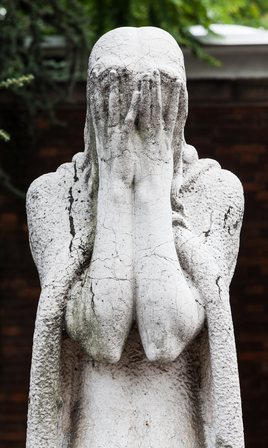The Death of Grief

The field of psychiatric diagnosis suffered a significant loss in the spring of 2013 with the death of the bereavement exclusion. It was not a peaceful ending, as several experts fought desperately to keep it alive within DSM-5. But the efforts of psychologists like Joann Cacciatore and psychiatrists such as Allen Frances were not successful. The American Psychiatric Association published the DSM-5 without the bereavement exclusion and effectively eliminated any diagnostic distinction between bereavement and major depression. Grief, for all intensive purposes, was dead.
Dr. Joann Cacciatore, a psychologist who specializes in counseling individuals affected by traumatic death, lamented this passing in her article, “The Death of Grief, the Birth of Mental Illness.” She said: “Grief is not a disease, it is not an illness, it is not depression. It is in fact, an expression of love. Grief can only be a disease if love is.” She noted how the change increased the likelihood that grief would be misdiagnosed as Major Depressive Disorder and then mistakenly treated with psychotropic medications. “There is no sound evidence that they are effective for grief. Research shows that bereaved parents are already medicated earlier than can be justified by current evidence.”
We are saddened and disappointed by the recent announcement that the DSM-5 task force has finalized the decision to eliminate the bereavement exclusion from the Major Depressive Disorder diagnosis in the upcoming edition of the manual. This move will allow clinicians, including counselors, general physicians, social workers, and psychiatrists, to diagnose a major mental disorder in bereaved parents and other grieving individuals as early as two weeks following the death of a loved one should they meet the DSM-5’s criteria for depression. Importantly, many of you will recognize these criteria which include sadness, feelings of emptiness, crying, sleep and weight changes, guilt and regrets, and loss of interest or energy. Yet, all of these symptoms are quite common in grief, and particularly after the death of a baby or child which evokes enduring and intense reactions in parents.
Allen Frances, a psychiatrist and chair of the DSM-IV, repeatedly pleaded with the APA to not medicalize grief in “Last Plea to DSM 5: Save Grief from the Drug Companies.” He even ranked it as the second worst mistake within the DSM-5. He noted it would be a “bonanza for drug companies, but a disaster for grievers.” Frances referenced and quoted the concerns of Joann Cacciatore, Russell Friedman (the co-founder of The Grief Recovery Institute Educational Foundation) and Jerry Wakefield, a professor of Social Work. Frances said: “The DSM 5 medicalization of grief has been opposed by editorials and scientific papers in the major medical and scientific journals, by hundreds of newspaper articles.”
After 40 years and lots of clinical experience, I can’t distinguish at two weeks between the symptoms of normal grief and the symptoms of mild depression- and I challenge anyone else to do so. This is an inherently unreliable distinction. And I know damn well that primary care doctors can’t do it in a 7 minute visit. This should have been the most crucial point in DSM 5 decision making because primary care docs prescribe 80% of all antidepressants and will be most likely to misuse the DSM 5 in mislabeling grievers. . . . Grief is a normal and inescapable part of the human condition, not to be confused with psychiatric illness. Let us respect the dignity of mourning and treat it medically only when it becomes melancholia.
Another eminent psychiatrist, Ronald Pies, disagreed with Allen Frances. He believes eliminating the bereavement exclusion was a reasonable decision. Pies said grief and depression are distinct constructs and bereavement does not “immunize” the person from major depression. He said the bereavement exclusion was removed from the DSM-5 for two main reasons: 1) major depression is potentially a lethal disorder, “with an overall suicide rate of about four percent”; and 2) there is no clinical or scientific evidence to distinguish bereavement-related grief from major depression. “Disqualifying a patient from a diagnosis of major depression” after the death of a loved one “closes the door on potentially life-saving interventions” (meaning medication).
It is important to understand that the DSM-5 criteria merely allow the diagnosis of MDD when the recently bereaved person meets all required symptom, severity, duration, and impairment criteria for MDD. Nothing in the manual compels a diagnosis of MDD shortly after bereavement.
In conclusion, Pies said while normal grief should not be medicalized, neither should major depression be normalized simply because it occurred “in the context of recent bereavement.” Dr. Pies seems to be arguing that the problems of a “falsely positive” in diagnosis of major depression in the context of bereavement are outweighed by the dangers from a “false negative” in diagnosis. Yet there are some who would strongly dispute this conclusion. Instead they see removing the bereavement exclusion as an example of how psychiatry relentlessly seeks to expand its reach.
In “Elimination of the Bereavement Exclusion: History and Implications,” psychologist Philip Hickey gave a history of the DSM and how the bereavement exclusion was first added, then whittled away over time. He noted how the DSM-I did not suggest its “disorders” were chemical imbalances or “illnesses-just-like-diabetes.” Rather, the “disorders” were conceived as reactions of the personality and believed to be of “psychogenic origin.” Hickey then gave a couple of quotes from the DSM-I illustrating his point.
The emphasis on psychological explanations was not merely a reflection of Adolf Meyer’s influence, but a reflection of the fact that a great many psychiatrists at that time (1952) subscribed to this position and were entirely comfortable with these types of psychoanalytic explanations.
But the introduction of antipsychotic and antidepressant medications in the 1950’s changed things. They offered a pathway to “prima facie medical legitimacy.” What was needed was a label that posed as a diagnosis; time for a 15-minute med check; and a quickly-written prescription. “No longer would it be necessary to delve collaboratively and time-consumingly into a client’s childhood conflicts, current fears, or counter-productive relationships.” Don’t be too quick to dismiss Hickey’s rhetoric. In an address to the American College of Neuropsychopharmacology in 2000, Allen Frances said the DSM system and psychopharmacology grew up together “and have had a strong influence upon one another.”
The psychopharmacological revolution required that there be a method of more systematic and reliable psychiatric diagnosis. This provided the major impetus for the development of the structured assessments and the research diagnostic criteria that were the immediate forerunners of DSM-III. In turn, the availability of well-defined psychiatric diagnoses stimulated the development of specific treatments and increasingly sophisticated psychopharmacological studies.
Hickey said as more psychiatric drugs came to market in the 1960s, “it became increasingly clear the psychogenic framework of the DSM-I had to go.” Thus a movement to develop a cause-neutral diagnostic system began with the DSM-II and continued on through the DSM-III under the guidance of Robert Spitzer. The concept of cause-neutrality, according to Hickey, meant that: “regardless of why a person is despondent, if he scores five or more yeses on the checklist, he has major depression, the ‘illness,’ and therefore needs medical treatment.” Over time, as the use of DSM diagnostic criteria became central to the conceptualization of depression and grief, the bereavement exclusion included by Robert Spitzer in the DSM-III seemed more and more problematic for mainline psychiatry. And bereavement as a cause of grief-related depression became increasingly irrelevant.
The death of grief is inversely related to the birth and growth of what Hickey called the biological-pathology perspective. The bereavement exclusion was finally pronounced dead with the publication of DSM-5 in 2013. “The bogus cause-neutral perspective (in reality the bogus biological-pathology perspective) was now the de facto psychiatric position, with no exceptions.”
The notion that one can gain an understanding of a person’s sadness by ignoring its causes and contexts, and simply bumping his superficial presentation against a fabricated checklist, and seeing if he scores hits on at least five, is simply inane. It’s like trying to understand a poem by counting the words. Anyone with the slightest compassion or understanding of human experience can see this.
For more on the concerns with psychiatric diagnosis see: “Where There’s Smoke …” and “Psychiatric Huffing and Puffing.” For more on the APA actions on bereavement, see: “Pathologizing Grief.”

